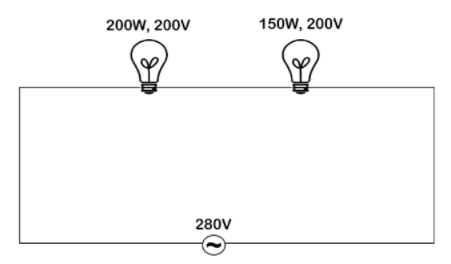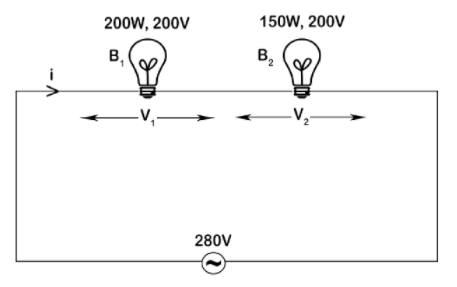
Find the power of each bulb and which bulb will glow brighter in the circuit shown below. If the power source is replaced by a 440V supply which bulb will fuse first.


Answer
459.9k+ views
Hint: When two bulbs are connected in series, the voltage drop across them is different for each but the current through each bulb is the same. The bulb whose power rating is less will fuse before the bulb whose power rating is higher in comparison.
Complete step by step answer:
Consider the circuit below, the voltage drop across bulb ${{B}_{1}}$ is ${{V}_{1}}$ and the voltage drop across bulb ${{B}_{2}}$ is ${{V}_{2}}$. The current through the circuit is I and the voltage source is 280V.

Let us calculate the resistances due to the bulbs in the circuit,
For bulb ${{B}_{1}}$,
${{R}_{1}}=\dfrac{{{V}_{1}}^{2}}{{{P}_{1}}}$ ….(i)
Putting the values in above equation we get,
${{R}_{1}}=\dfrac{{{200}^{2}}}{200}\Omega $
$\Rightarrow {{R}_{1}}=200\Omega $
For bulb ${{B}_{2}}$,
${{R}_{2}}=\dfrac{{{V}_{2}}^{2}}{{{P}_{2}}}$ ….(ii)
Putting the values in above equation we get,
${{R}_{2}}=\dfrac{{{200}^{2}}}{150}\Omega $
$\Rightarrow {{R}_{2}}=266.67\Omega $
(I) Now, calculating the voltages across each bulb:
For bulb ${{B}_{1}}$,
${{V}_{1}}={{V}_{s}}\times \dfrac{{{R}_{1}}}{{{R}_{1}}+{{R}_{2}}}=280\times \dfrac{200}{200+266.67}=119.99V$
$\Rightarrow {{V}_{1}}=120V$ on rounding it.
Where, ${{V}_{s}}$ is the source voltage.
For bulb ${{B}_{2}}$,
${{V}_{2}}={{V}_{s}}\times \dfrac{{{R}_{2}}}{{{R}_{1}}+{{R}_{2}}}=280\times \dfrac{266.76}{200+266.67}=160V$
Therefore, the bulb ${{B}_{2}}$with greater voltage drop in the circuit will grow brighter than bulb ${{B}_{1}}$.
(II) Now, calculating the power consumed by both bulbs,
For bulb ${{B}_{1}}$,
${{P}_{1}}=\dfrac{V_{1}^{2}}{{{R}_{1}}}=\dfrac{{{199.99}^{2}}}{200}W=199.98W=200W$
For bulb ${{B}_{2}}$,
${{P}_{2}}=\dfrac{V_{2}^{2}}{{{R}_{2}}}=\dfrac{{{160}^{2}}}{266.67}W=95.99W=100W$
(III) If the source is replaced by 440V then,
For bulb ${{B}_{1}}$,
${{V}_{1}}={{V}_{s}}\times \dfrac{{{R}_{1}}}{{{R}_{1}}+{{R}_{2}}}=440\times \dfrac{200}{200+266.67}=188.57V=189V$
For bulb ${{B}_{2}}$,
${{V}_{2}}={{V}_{s}}\times \dfrac{{{R}_{2}}}{{{R}_{1}}+{{R}_{2}}}=440\times \dfrac{266.76}{200+266.67}=251.43V=251V$
Therefore, bulb ${{B}_{2}}$ will fuse first as the voltage across ${{B}_{2}}$ is more than the allowed i.e. its rating voltage 200V.
Additional Information:
When two bulbs are connected in series, the voltage drop across them is different for each but the current through each bulb is the same and when two bulbs are connected in parallel, the voltage drop across them is same for each but the current through each bulb is different.
Note:
Bulbs when connected in series do not glow to their maximum brightness and if one of the bulbs in series if fused then the circuit becomes an open circuit and none of the bulbs glow. Thus, in everyday use the bulbs are connected in parallel connection to avoid such problems.
Complete step by step answer:
Consider the circuit below, the voltage drop across bulb ${{B}_{1}}$ is ${{V}_{1}}$ and the voltage drop across bulb ${{B}_{2}}$ is ${{V}_{2}}$. The current through the circuit is I and the voltage source is 280V.

Let us calculate the resistances due to the bulbs in the circuit,
For bulb ${{B}_{1}}$,
${{R}_{1}}=\dfrac{{{V}_{1}}^{2}}{{{P}_{1}}}$ ….(i)
Putting the values in above equation we get,
${{R}_{1}}=\dfrac{{{200}^{2}}}{200}\Omega $
$\Rightarrow {{R}_{1}}=200\Omega $
For bulb ${{B}_{2}}$,
${{R}_{2}}=\dfrac{{{V}_{2}}^{2}}{{{P}_{2}}}$ ….(ii)
Putting the values in above equation we get,
${{R}_{2}}=\dfrac{{{200}^{2}}}{150}\Omega $
$\Rightarrow {{R}_{2}}=266.67\Omega $
(I) Now, calculating the voltages across each bulb:
For bulb ${{B}_{1}}$,
${{V}_{1}}={{V}_{s}}\times \dfrac{{{R}_{1}}}{{{R}_{1}}+{{R}_{2}}}=280\times \dfrac{200}{200+266.67}=119.99V$
$\Rightarrow {{V}_{1}}=120V$ on rounding it.
Where, ${{V}_{s}}$ is the source voltage.
For bulb ${{B}_{2}}$,
${{V}_{2}}={{V}_{s}}\times \dfrac{{{R}_{2}}}{{{R}_{1}}+{{R}_{2}}}=280\times \dfrac{266.76}{200+266.67}=160V$
Therefore, the bulb ${{B}_{2}}$with greater voltage drop in the circuit will grow brighter than bulb ${{B}_{1}}$.
(II) Now, calculating the power consumed by both bulbs,
For bulb ${{B}_{1}}$,
${{P}_{1}}=\dfrac{V_{1}^{2}}{{{R}_{1}}}=\dfrac{{{199.99}^{2}}}{200}W=199.98W=200W$
For bulb ${{B}_{2}}$,
${{P}_{2}}=\dfrac{V_{2}^{2}}{{{R}_{2}}}=\dfrac{{{160}^{2}}}{266.67}W=95.99W=100W$
(III) If the source is replaced by 440V then,
For bulb ${{B}_{1}}$,
${{V}_{1}}={{V}_{s}}\times \dfrac{{{R}_{1}}}{{{R}_{1}}+{{R}_{2}}}=440\times \dfrac{200}{200+266.67}=188.57V=189V$
For bulb ${{B}_{2}}$,
${{V}_{2}}={{V}_{s}}\times \dfrac{{{R}_{2}}}{{{R}_{1}}+{{R}_{2}}}=440\times \dfrac{266.76}{200+266.67}=251.43V=251V$
Therefore, bulb ${{B}_{2}}$ will fuse first as the voltage across ${{B}_{2}}$ is more than the allowed i.e. its rating voltage 200V.
Additional Information:
When two bulbs are connected in series, the voltage drop across them is different for each but the current through each bulb is the same and when two bulbs are connected in parallel, the voltage drop across them is same for each but the current through each bulb is different.
Note:
Bulbs when connected in series do not glow to their maximum brightness and if one of the bulbs in series if fused then the circuit becomes an open circuit and none of the bulbs glow. Thus, in everyday use the bulbs are connected in parallel connection to avoid such problems.
Recently Updated Pages
Master Class 12 Social Science: Engaging Questions & Answers for Success

Class 12 Question and Answer - Your Ultimate Solutions Guide

Class 10 Question and Answer - Your Ultimate Solutions Guide

Master Class 10 Science: Engaging Questions & Answers for Success

Master Class 10 Maths: Engaging Questions & Answers for Success

Master Class 9 General Knowledge: Engaging Questions & Answers for Success

Trending doubts
The gas that burns in oxygen with a green flame is class 12 chemistry CBSE

The probability that a leap year will have only 52 class 12 maths CBSE

Describe the poetic devices used in the poem Aunt Jennifers class 12 english CBSE

And such too is the grandeur of the dooms We have imagined class 12 english CBSE

What does the god that failed refer to class 12 english CBSE

Which country did Danny Casey play for class 12 english CBSE




